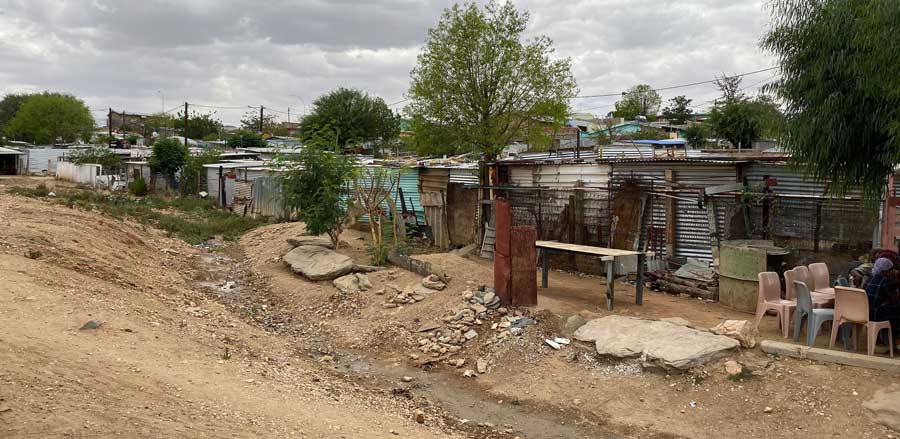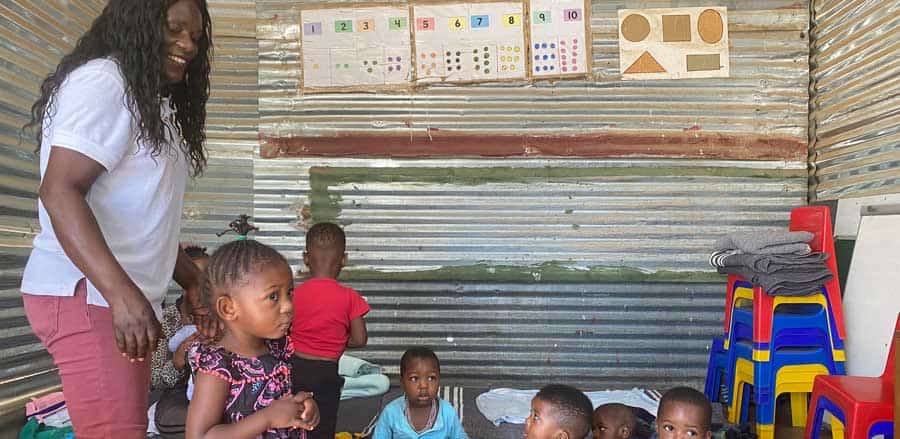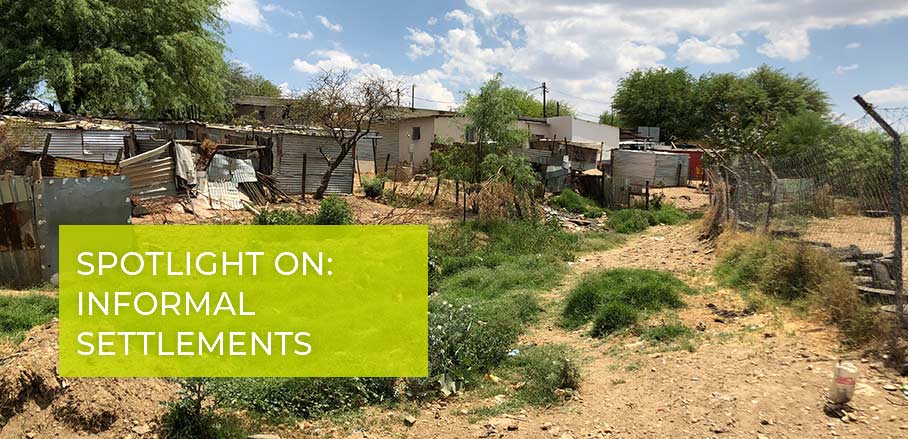Informality and Climate Resilience – The Story of Onyika Settlement, Windhoek, Namibia
In Namibia, the major share of urban growth is informal, with an estimated 30-40 per cent of the population living in informal settlements, with trends projecting shacks to become the predominant form of housing by 2025. Being especially vulnerable to climate change, these forms of settlements require special attention in the development of climate resilience strategies.
Life in Onyika
Onyika No. 2 is an informal settlement on the outskirts of Windhoek. Houses are huddled together along dusty and disorientating streets. The smell of human waste floats through the air, burning your eyes, which are fixed to the ground to avoid stepping into streams of sewage and the waste that lies scattered, collecting in the dry riverbed and its surrounding drainage area.

© GIZ/Kirsty Watermeyer
Johanna Sheehama is the principal of the J. Sheehama Pre-Primary & Day Care Centre. She has lived in Onyika her entire life. The difficulties of poverty are evident as you step inside her school. One single room constitutes the whole day-care centre, built out of zinc sheets, floors simply covered with sand. Creatively and almost defiantly, she has made a bed for the children at her school, out of various blankets. A corner of comfort where they can rest snuggly despite their surroundings. As the sun bakes down, Johanna proudly shows off her few toys and learning materials. Every day, many children from around the community walk to Johanna’s school; the number fluctuates based on what is happening in the life of her community members – the informality of the surroundings translates to the informality of every-day life.

© GIZ/Kirsty Watermeyer
Lack of Infrastructure and Environmental Hazards
The City Administration has provided basic infrastructure for the residents in Onyika, however not all households are connected yet. Especially, some of the houses at the outskirts of the settlement are not permanent structures andhaveno sanitation or toilet facilities. Children are often seen climbing over piles of trash to brave the dry riverbed for a shrub or bush to use as a toilet. Besides the threats of criminals in the area, the real danger for children here is the health risks that their lavatories provide as they step over accumulated human waste baking in the sun.
Rapid growth in migration from rural to urban spaces has put huge demand on existing infrastructure. Many people, desperate for a home, have built their dwelling informally, in tightly confined spaces and in the path of a dangerous natural phenomenon: without drainage, water becomes a villain.
Namibia is a semi-arid country where rain fall is celebrated by most town dwellers. Yet, according to the National Climate Change Strategy and Action Plan 2013-2020, “Namibia had to deal with an increasing number of floods and drought-related events in the past decade. Climate change is likely to exacerbate the impact and frequency of these extreme events.”
Windhoek, which has the highest number of informal settlements in the country, is especially prone to environmental hazards. Most informal settlements are especially vulnerable, as they are built on slopes and face an extreme risk from flash floods which are common in the rainy months.
An additional hazard is the pollution of already limited water resources due to open solid waste and the lack of sanitation infrastructure. Removal of vegetation and degradation in and around informal settlements – when trees are cut down to make space for make-shift homes – has proven to be another problem, removing necessary shelter from heat in a warming climate.
The Effect of Climate Change on Informal Living
Onyika’s informal settlements are especially vulnerable to environmental hazards: they are squeezed in next to each other on the slopes of mountain sides. When the floods come, they do so with such force as to wash away people’s homes and their few belongings, lost to the forces of nature.
Even more distressing, people often lose their children due to rapid and unannounced flash floods. “We are scared. Sometimes at the time of the flood, they get washed away with the flood. We’ve lost lots of children. The water is strong and moves fast” says Johanna.
She also highlights the dangers the floods bring in addition to the strong waters. “The dirty things come inside the house, the rubbish and all the (human) waste from the river”, referring to the waste that accumulates in the riverbed as people don’t have access to proper sanitation facilities. When the flood waters come, this waste is washed into people’s homes, piles of rubbish and human waste covering the ground.
Building Climate Resilience
In the face of all these problems, the residents of Onyika have decided to act upon them and to embark on a community-lead process of creating a climate resilient community. Together with donors, technical support organisations, climate change experts, and the City of Windhoek, a pilot project has been launched to provide climate-friendly solutions to improving life in this community. A list of possible interventions was proposed by the community and integrated with the help of a landscape architect, an urban design specialist, a traffic engineer and a waste specialist. In particular, it is envisaged to construct a bioswale system in order to create a water retention area that can filter contaminated water or greywater and convey stormwater runoff as well as to reorganise the current waste collection system of the community. In a later phase, it is planned to rehabilitate and revive the riverbed edge along the kindergarten, for example by clearing debris from the area, constructing permeable walkways and establishing small gardens.
It is hoped that this project will become a case study and testing ground to roll out to other informal settlements all over the country.
Still in the early stages of the project, the excitement in the community is evident: community members have taken action and begun to clear the rubbish from the streets in preparation for the coming development. A driving factor was a community workshop they attended, which informed on climate change, the dangers of pollution and the risk factors their community faces due to their flood prone location, the large amounts of human waste, and the lack of vegetation in the area.
When asked what she hopes to see once development truly begins for her community, Johanna notes: “One day Onyika will look like a town, not like it is now, but a real town and this will make me so happy.”
